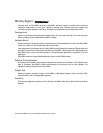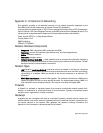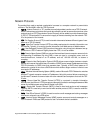Page 264 SonicWALL Internet Security Appliance Administrator’s Guide
Network Protocols
The method that used to regulate a workstation’s access to a computer network to prevent data
collisions. The SonicWALL uses the TCP/IP protocol.
• TCP/IP - Internet Protocol, or "IP", provides connectionless data transfer over a TCP/IP network.
Since IP alone does not provide end-to-end data reliability as well as some other services, other
protocols such as TCP (Transmission Control Protocol) can be added to provide these services.
In TCP/IP, TCP works with IP to ensure the integrity of the data traveling over the network. TCP/
IP is the protocol of the Internet.
• FTP - File Transfer Protocol (FTP) is used to transfer documents between different types of com-
puters on a TCP/IP network.
• HTTP - HyperText Transfer Protocol (HTTP) is a widely used protocol to transfer information over
the Internet. Typically, it is used to transfer information from Web servers to Web browsers.
• UDP - User Datagram Protocol (UDP) transfers information using virtual ports between two ap-
plications on a TCP/IP network. Slightly faster than TCP, it is not as reliable.
• DNS - Domain Name System (DNS) is a protocol that matches Internet computer names to their
corresponding IP addresses. By using DNS, a user can type in a computer name, such as
www.sonicwall.com, instead of an IP address, such as 192.168.168.168, to access a
computer.
• DHCP - Dynamic Host Configuration Protocol (DHCP) allows communication between network
devices and a server that administers IP numbers. A DHCP server leases IP addresses and other
TCP/IP information to DHCP client that requests them. Typically, a DHCP client leases an IP
address for a period of time from a DHCP server which allows a larger number of clients to use
a set pool of IP addresses.
• WINS - Windows Internet Naming System (WINS), used on Microsoft
®
TCP/IP Networks, matches
Microsoft
®
network computer names to IP addresses. Using this protocol allows computers on
the Microsoft
®
network to communicate with other networks and computers that use the TCP/
IP suite.
• HTTPS - Secure HyperText Transfer Protocol (HTTPS) is a protocol to transfer information
securely over the Internet. HTTPS encrypts and decrypts information exchanged between a Web
server and a Web browser using Secure Socket Layer (SSL).
• SMTP - Simple Mail Transfer Protocol (SMTP) is used to send and receive e-mail messages.
Typically, SMTP is used only to send e-mail while another protocol, POP3, is used to receive e-
mail messages.
• POP3 - Post Office Protocol 3 (POP3) is used to receive e-mail messages and storing messages
on a server, referred to as a POP server.
• ICMP - Internet Control Messages Protocol (ICMP) reports errors and controls messages on a
TCP/IP network. PING uses ICMP protocol to test if a network device is available.


















